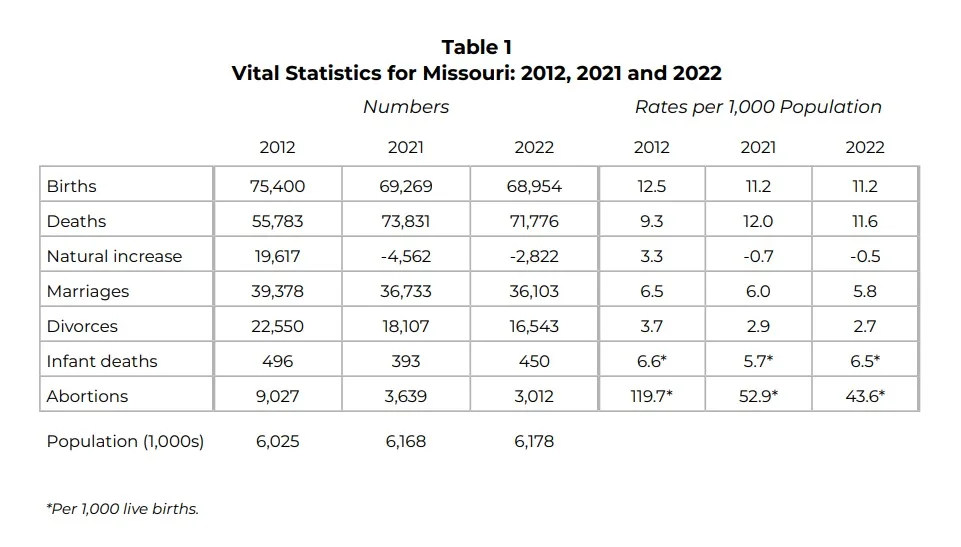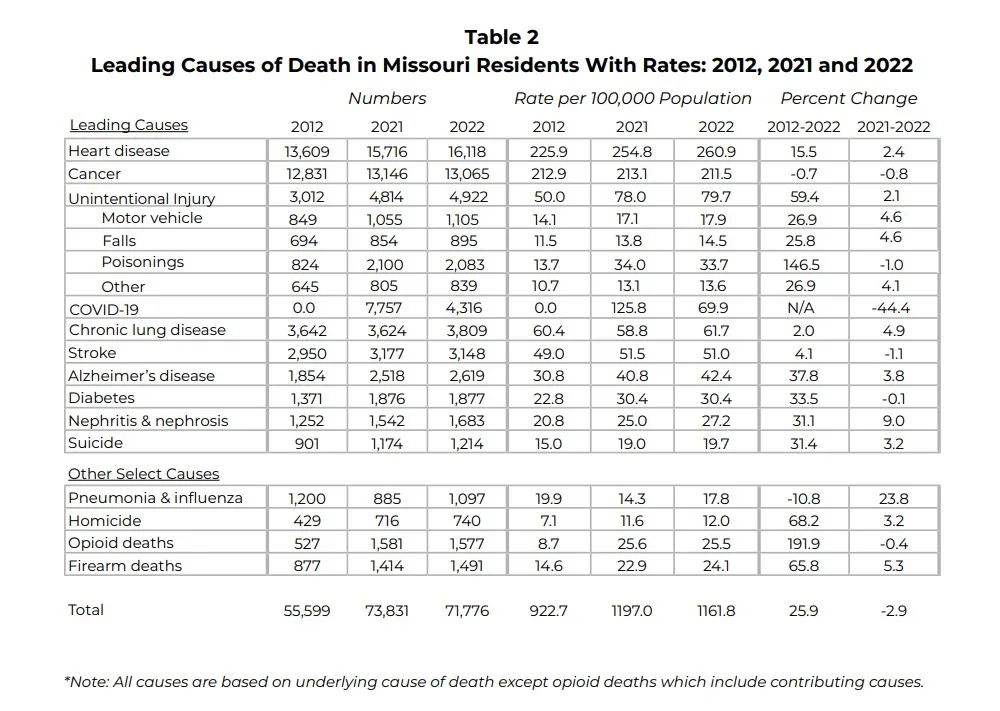Vital Statistics
Missouri resident deaths decreased by over 2,000 in 2022 from 73,831 in 2021 to 71,776 deaths as the intensity of the COVID-19 pandemic sharply reduced. COVID-19 deaths decreased by 44% in 2022 from 7,757 in 2021 to 4,316. Births continued to decrease slightly as 68,954 Missouri infants were born in 2022, a decrease of 315 from 2021’s number of 69,269. Despite the decrease in mortality, deaths still outnumbered births for the third year in a row, which is referred to as a natural decrease. The 2022 natural decrease of 2,822 was down from the 2021 natural decrease of 4,562. Before the pandemic started in 2020, there were more than 100 consecutive years of natural increases in Missouri.
As a result of the decreased Missouri mortality, the state life expectancy increased in 2022 by 0.6 years from 74.8 in 2021 to 75.4 years in 2022. Despite the increase, the 2022 life expectancy was still two years lower than the pre-pandemic level of 77.4 years in 2019. Male life expectancy increased by 0.9 years from 71.7 in 2021 to 72.6 years in 2022. Female life expectancy increased by 0.4 years from 78.0 in 2021 to 78.4 years in 2022. The difference in life expectancy between the two genders decreased from 6.3 to 5.8 years in 2022.
Marriages and divorces both decreased in 2022. Marriages decreased by 1.7% from 36,733 in 2021 to 36,103 in 2022. Divorces decreased by 8.6% in 2022 as 16,543 Missouri marriages were dissolved compared with 18,107 in 2021. The marriage to divorce ratio increased from 2.03 in 2021 to 2.18 in 2022.

Leading Cause of Death
As reflected in Table 2, COVID-19 went from the third leading cause of death in Missouri in 2020 and 2021 to the fourth leading cause in 2022, as unintentional injuries (accidents) moved into number three. Heart disease and cancer continued as numbers one and two, respectively. Following COVID-19 in leading causes of deaths were chronic lung disease, stroke, Alzheimer’s disease, diabetes, nephritis (kidney disease) and suicide. Nearly two-thirds of 2022 COVID-19 deaths occurred in January and February when the Omicron variant was prevalent. After February, COVID-19 was the seventh leading cause of death. Six of the ten leading causes increased in 2022, while four decreased.
The largest percentage increase in deaths was for nephritis at 9% followed by chronic lung disease at 4.9%. Deaths from Alzheimer’s disease, suicide, heart disease and unintentional injuries also increased in 2022. Among the unintentional injuries, motor vehicle crashes and falls contributed the most to increases. As mentioned earlier, COVID-19 deaths declined by 44% in 2022, while mortality from stroke, cancer and diabetes all showed slight decreases.
The 2022 increase of 2.1% in unintentional or accidental deaths was relatively modest, but over the last decade this category has increased nearly 60% and 2022 represents a record high death count of 4,922. The large ten-year increase in unintentional injury deaths was primarily associated with drug overdose deaths (accidental poisonings), which increased by 146% from 2012 to 2022. Opioid-related deaths, which are included in accidental poisonings, as well as some suicides and homicides, accounted for 1,577 deaths in 2022, just 4 below the record 1,581 deaths in 2021, but triple the number in 2012 of 527. Fentanyl continued to be the principal drug most affecting the continual high rate of opioid deaths, as well over 90% of the opioid deaths were fentanyl related.
Opioid deaths are now expanding outside the St. Louis area. In 2019, more than 67% of Missouri’s opioid related deaths occurred in St. Louis Metropolitan residents. In 2022, this proportion dropped to 52%. Meanwhile, the greater St. Louis area (including St. Louis Metropolitan) opioid deaths increased by 15% and Missouri opioid deaths outside the St. Louis area doubled. Opioid deaths in Jackson County (Kansas City area) residents nearly tripled from 2019 to 2022.
Homicides (not in the top ten causes) increased by 3.2% in 2022 to 740 deaths and suicides increased by 3.2% from 1,174 in 2021 to 1,214 in 2022. From 2012 to 2022, homicides increased by two-thirds and suicides rose by one-third. The use of firearms is a factor in both suicides and homicides. Firearm related homicides and suicides followed the same pattern as total homicides and suicides with both increasing. About 66% of suicides and 85% of homicides were firearm-related in 2022. Total firearm-related deaths increased by over 5% from 1,414 in 2021 to 1,491 in 2022, another record high.

Maternal and Child Health
Missouri resident births decreased by about 300 from 2021 to 2022, marking 2022 the 14th decrease in the last 15 years. Since Missouri births peaked in 2007 at 81,883, the number has decreased by 15.8% to 68,954 in 2022, the lowest Missouri birth number since 1976.
Teen births have been decreasing in Missouri for about 30 years, with numbers currently only about one-third of the number 30 years ago and half of the number ten years ago. However, the decrease seemed to be flattening in 2022, as the number of births under age 20 decreased by 1% from 2021 to 2022, and the number under 18 actually increased slightly in 2022.
The infant death rate increased by 14% from 5.7 in 2021 to 6.5 per 1,000 live births in 2022, the highest rate since 2016. The rate increased for both the neonatal (age less than 28 days) and the post neonatal (age 28 days to 11 months) periods by similar amounts. The neonatal rate is primarily due to prematurity-related causes while the post neonatal rate is more related to care at home. The increase occurred for both white non-Hispanic (20% increase) and Black non-Hispanic infants (8% increase). The Black infant death rate of 13.2 per 1,000 live births was 2.4 times the white rate of 5.5, a decrease from the 2.65 ratio in 2021, but higher than the 2.2 ratio of Black to white infant mortality in 2012.
The rate of low birth weight (less than 2,500 grams) infants increased to a record 9.1% in 2022 from 8.9% in 2021 and 7.8% in 2012. The 2022 low birth weight rate for Black Non-Hispanic infants was 16.5%, more than double the rate for white Non-Hispanic infants of 7.8%. The related rate of preterm births (delivering before 37 weeks of pregnancy) remained at 11.3% in 2022, the same rate as in 2021.
The rate of inadequate prenatal care increased from 19.1% in 2021 to 20.6% in 2022. Inadequate prenatal care is defined as fewer than five visits for preterm pregnancies, fewer than eight visits for term pregnancies or prenatal care beginning after the first four months of pregnancy. The rate uses the number of live births with known prenatal care as the denominator.
Other maternal and child health indicators presented in Table 3 show the following for 2022:
- The rate of out-of-wedlock births decreased from 40% to 39.2% between 2021 and 2022.
- Multiple births increased from 3.3% in 2021 to 3.5% in 2022.
- Short (less than 18 months) spacing between births decreased from 12.6% in 2021 to 12.5% in 2022.
- The number of mothers on Medicaid increased slightly but decreased for those on WIC and food stamps.
- The rate of mothers smoking during pregnancy decreased to 8% in 2022 from 10.1% in 2021 and 18.1% in 2012.
- C-sections increased during the last year from 30.2% in 2021 to 30.4% in 2022.
- The rate of births to obese (BMI > 30) mothers increased to 32.9% in 2022 from 31.8 in 2021 and 24.6 in 2012.
- Abortions (Table 1) decreased in 2022 as 3,012 Missouri resident pregnancies were terminated compared with 3,639 in 2021. This change is difficult to interpret as thousands of Missouri women obtain abortions in states that do not provide Missouri with individual abortion records.

Conclusion
In summary, the COVID-19 pandemic was significantly diminished in 2022, especially after February, as total deaths decreased by about 3% and COVID-19-related deaths decreased by 44%. Life expectancy increased by 0.6 years from 2021 to 75.4 years but was still about two years less than it was in the latest pre-pandemic year of 2019. Births declined slightly again and deaths out-numbered births for the third year in a row after never previously happening. Infant mortality reached its highest level since 2016, suicides and homicides increased, and opioid overdose deaths continued at a near record high.
This is a copy of the 2022 FOCUS Report produced by the Breau of Health Care Analysis and Data Dissemination under the Missouri Department of Health and Senior Services. To view an official copy of this report please go to FOCUS Articles | Health & Senior Services (mo.gov)


